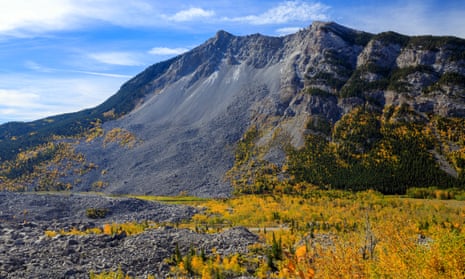Before sunrise on the morning of 29 April 1903, a deep rumble echoed through Crowsnest Valley in western Alberta, Canada. The peak of Turtle Mountain had collapsed, sending a block of limestone nearly 1km wide and weighing 110m metric tonnes hurtling towards the town of Frank, a coalmining community of 600 people.
In less than two minutes, 100 people are believed to have been killed in what remains Canada’s deadliest rockslide. A dozen bodies were recovered, but the vast majority of victims remain buried under boulders the size of vehicles.
“We don’t know exactly where the people that are buried beneath them are,” said David McInytre, a resident of the nearby community of Crowsnest Pass. “And so the debris field has become a sea of tombstones.”
Now, a controversial planned expansion of the highway connecting Alberta to British Columbia would alter the site, prompting worry and frustration from residents that a “sacred place” could soon be destroyed.
Turtle Mountain, part of the broader Rocky Mountain range, has long been known as “the mountain that moves” in the oral traditions of the Ktunaxa and Blackfoot peoples, who reportedly refused to camp in its vicinity.
Coalminers felt tremors from within the mountain in the weeks leading up to the slide and mine shafts splintered days before as the mountain’s internal shifting amplified.
Experts say the physical makeup of the mountain – limestone atop softer rock – is a common feature of the Rocky Mountains. Slides are common, and experts all agree another large slide from Turtle Mountain will happen again.
Worries of another collapse didn’t stop the construction of Frank –and fears of a second slide haven’t stopped recent efforts by the municipality of Crowsnest Pass to push development closer to the mountain.
The Frank Slide area was given two designations in the 1970s that gave it protection under the Historical Resources Act, with the intention of protecting the rock side from further disturbance and development.
“That should have been enough to stop things,” said McIntyre. “But now we have a government and a transportation department that says the designation doesn’t matter any more, that after 50 years we can just throw that in the trash can and can destroy it.”

McIntyre and his wife Monica Field have for decades managed the Frank Slide Interpretive Centre, which welcomes visitors from around the world who stand in awe at the physical devastation of the slide.
“Even though the slide happened 120 years ago, it looks like it happened yesterday,” said McIntyre.
The community recently commemorated the anniversary of the disaster and just days later learned the highway expansion, discussed for nearly half a century, had received final approvals. A two-year engineering study is now under way.
In a statement, the province’s transportation ministry said it was “aware of sensitivity of Frank Slide historic site” and that while efforts would be made to minimize impact, there could be “slight refinements in the final design”.
In addition to fears that a second slide could “obliterate” portions of the expanded highway, McIntyre worries the importance of the site could fade away.
“Societies tend to commemorate places of mass death. We have worked for almost four decades to honour and protect this place,” said MacIntyre. Signs warn passersby to respect the area and not remove any rocks. “Now, that doesn’t matter, if you can go in there with heavy equipment and just take out countless tons of rock and destroy what is seen as an international cemetery.”
A looming provincial election is a glimmer of hope for residents who opposed the project.
“I’m hopeful that we might get a government that says when the province makes a designation, it means something. We don’t say it’s important one day and then destroy it tomorrow.”
